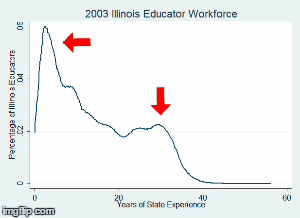How has the Illinois educator workforce changed over time? Illinois' average years of experience has held roughly constant at 13 for the past decade. But while the average stayed about the same, there were significant changes going on underneath. The images below show how the shape of Illinois’ educator workforce experience has fluctuated over time (skip to the bottom of this post to see the full gif).
The following data comes from a longitudinal dataset that Chad Aldeman, Melissa King, and I compiled from the Illinois Teacher Service Records (now known as the Employment Information System). Since 2001, the Illinois State Board of Education has been publishing annual information describing characteristics of all teachers, principals, and other school support staff employed in Illinois public schools. The majority (85 percent) of the sample are teachers.
On the front end, Illinois' new hires fluctuate based on district hiring practices. You can see this in the first peak in each of the graphs below, for the years 2003 and 2005.
When districts hire more people, the graph picks it up as a noticeable peak at the front end. When hiring falls, the peak gets shorter and spreads further to the right. This is the natural effect of slower hiring rates, and shows how employees start to age into the workforce and gain more experience.
There's a second distinct peak in the graphs, a group of educators with 20-30 years of experience. This bulge likely represents Illinois educators from the Baby Boom generation.
Notice how the second peak bulges and shifts right as these teachers remain in the workforce and approach what will likely be full-career pension benefits.
By the end of this time period, this second bulge begins to shrink as these Baby Boom teachers begin to retire and leave the workforce.
Here is the full gif of Illinois’ workforce from 2002 to 2012. Again, remember that the "average" years of experience stays nearly constant through all these years, but the overall pattern shifted. Watch how the state's school districts changed their hiring patterns through the years, and how a large group of Baby Boomers slowly began to age out of the workforce.

